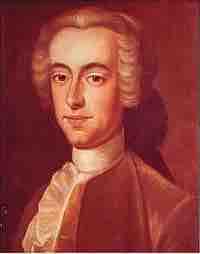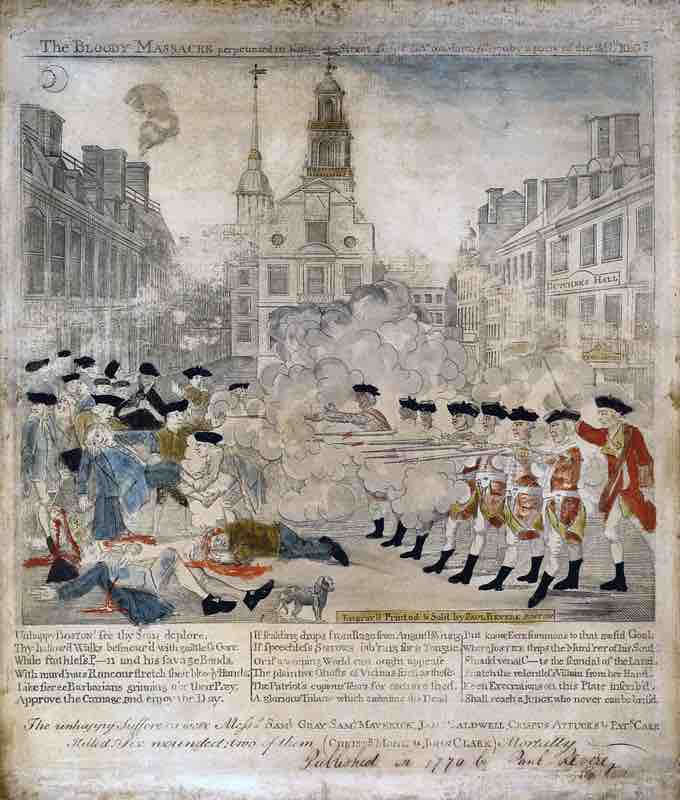Overview: The Boston Massacre
The Boston Massacre, called "The Incident on King Street" by the British, was an incident on March 5, 1770, in which British Army soldiers killed five colonial civilian men. British troops had been stationed in Boston since 1768, to protect and support crown-appointed colonial officials attempting to enforce unpopular parliamentary legislation and taxes. Amid ongoing tension between the colonial population and the soldiers, a mob formed around a British sentry, who was subjected to verbal abuse and harassment. He was eventually supported by eight additional soldiers, who were further subjected to verbal threats and thrown objects. The soldiers fired into the crowd without orders, killing three people and wounding others. Two more people died later of wounds sustained in the incident.
The Incident
On the evening of March 5, Private Hugh White, a British soldier, stood on guard duty outside the Custom House on King Street. Edward Garrick began calling out insults to White and another British officer, Captain Lieutenant John Goldfinch. White left his post, challenged Garrick, and struck him on the side of the head with his musket. As Garrick cried in pain, one of his companions began to argue with White, attracting a larger crowd.
As the evening progressed, the crowd around Private White grew larger and more boisterous. Church bells were rung, which usually signified a fire, bringing more people out. Over 50 of the Bostonian townspeople gathered, throwing snowballs, rocks, and sticks at White and challenging him to fire his weapon. White, who had taken up a somewhat safer position on the steps of the Custom House, sought assistance. A non-commissioned officer and six privates of the 29th Regiment of Foot were sent with fixed bayonets to relieve White. When they reached Private White on the custom house stairs, the soldiers loaded their muskets and arrayed themselves in a semicircular formation. The soldiers were heckled by the mob as “lobster backs,” a reference equating them with bottom feeders.
After a tense standoff, the soldiers fired into the crowd. Rather than a disciplined volley (there were no orders given to fire), a ragged series of shots was fired, which hit 11 men. The crowd moved away from the immediate area of the Custom House but continued to grow in nearby streets. British soldiers adopted defensive positions in front of the State House. Acting Governor Thomas Hutchinson was summoned to the scene and was forced by the movements of the crowd into the council chamber of the State House. From its balcony, he was able to minimally restore order, promising that there would be a fair inquiry into the shootings if the crowd dispersed.
Five people in total were killed. Crispus Attucks, the first man killed—and, though no one could have known it then, the first official casualty in the war for independence—was of Wampanoag and African descent. The bloodshed illustrated the level of hostility that had developed as a result of Boston’s occupation by British troops, the competition for scarce jobs between Bostonians and the British soldiers stationed in the city, and the larger question of Parliament’s efforts to tax the colonies. In the days and weeks following the incident, a propaganda battle was waged between Boston's radicals and supporters of the government. Both sides published pamphlets that told strikingly different stories, which were principally published in London in a bid to influence opinion there.

Thomas Hutchinson
Thomas Hutchinson, governor of the Province of Massachusetts Bay.
Aftermath
The Boston Massacre is considered one of the most important events that turned colonial sentiment against King George III and British parliamentary authority. John Adams wrote that the "foundation of American independence was laid" on March 5, 1770, and Samuel Adams and other patriots used annual commemorations of the event to rally against British rule. Later events such as the Boston Tea Party further illustrated the crumbling relationship between Britain and its colonies. Although five years passed between the massacre and outright revolution, it is widely perceived as a significant event leading to the violent rebellion that followed.

Depiction of the Boston Massacre by Paul Revere
A sensationalized portrayal of the skirmish, later to become known as the "Boston Massacre," between British soldiers and citizens of Boston on March 5, 1770.